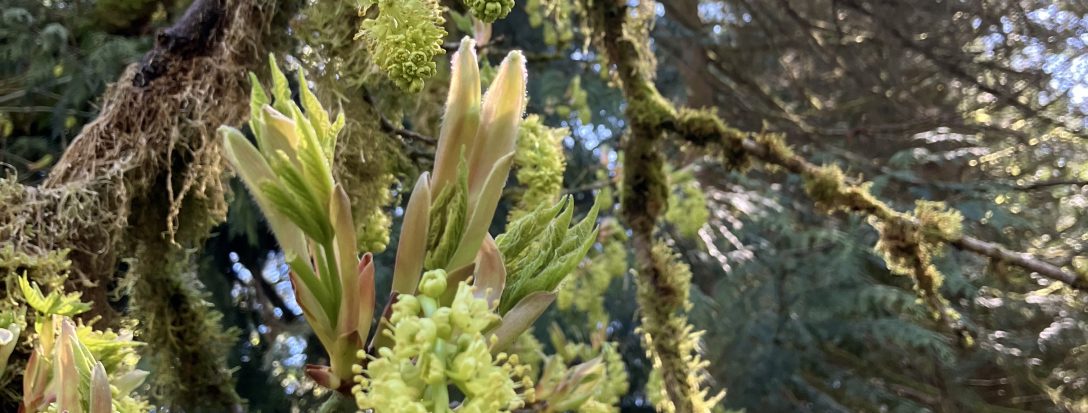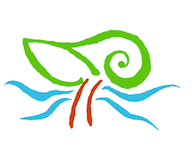
It’s The Mushroom Spring here at EEC Forest Stewardship! We’re out in our local public lands searching for treasure across the landscape (where appropriate). Keying in on human impact will make or break the future of wild mushroom foraging, please know before you go. As an enthusiastic mushroomer, I am thrilled to spot the first golden crown poking up through the duff, but this year, a dear friend who is also a fungal fan, spotted the chantrelle beauty below the trees well before me. The first rains of early Fall signal a rebirth in temperate northwest forests. Beneath the evergreen canopy, secret armies are on the march. Trees shed a lot of biomass, which builds a highway of needles and twigs; lattice network of nutrient exchange, much like the stock market of Wall Street, these orchestrated supply and demand chains pulse living symphonies through rooted nervous systems. Young trees “lay on the horn” and their nearby mothers extend nitrogen, carried on a living web of fungal fiber. These operations remain buried within the thick woody wilds, until cool damp conditions trigger a fruiting fantasia.

Though mushrooms are active at all times of year, equinox times are exceptional times for these mysterious magicians of decomposition. Here in North America, we’ve buried our ancient connection to this most potent Kingdom. Humans around the world have relied on fungi since the birth of evolution. We learned to leaven bread with wild yeasts, heal infection with mold, and harvest endless food and medicine in mushroom form. These jewels of the land are such abundant teachers, messengers of organically complex chemistry we are still trying to cypher. Mushrooms are ecological indicators in a landscape, sharing information above and below the earth’s surface. They share a close relationship with living matter, especially woody debris, yet are capable of breaking down more than rotting logs. Some species, like Pleurotus ostreatus, neutralize petroleum, and others like it can be instrumental in toxic cleanup across the planet. Here in Washington State, we’ve passed laws allowing mycological composting for human bodies. Imagine all the advantages fungi can offer if we look a little closer.

Forming relationship with mushrooms takes time, and a lot of in the field learning. I’ve talked extensively in this blog about safety and mushrooming, and still advocate experts teaching anyone serious about going mushroom harvesting. This is not a foraging journey to strike out on alone. Even after a decade of mushrooming in one bio-region, I still consider myself a beginner, and enjoy a great shared experience with close friends already versed in naturalist education. Sometimes I’m happy to take a total beginner into the woods for a few encounters, and chantrelles are one of the best to start your foraging adventure with, still, please take your first turn in the woods seeking these golden tickets with an experienced forager. The endless verity of fungi families can invite false identification, leading to upset stomachs or much much worse. Mushrooms can kill, so stick to berry patches you already know if you have any worries- mushrooming is not for everyone!
At opening mushroom harvesting day, 2021 (just another foraging day in Western Washington) I came across a great example of “look alike” species. It might not look similar to everyone, but an excited first time chantrelle picker could swipe up this mushroom without realizing the difference. Later, back at home sorting, you might catch it, but if you were to eat this fungal friend, its reaction to your stomach would be vile, and potentially hospital visit inducing. Would you instantly die from ingesting it? No, but long term damage of certain organs could occur. This is an important lesson in mushroom foraging for all to hear- go with a knowledgeable mushroomer and don’t experiment.
Here’s a side by side of chantrelle and hooded false morel to compare. What are the obvious similarities? How are the two mushrooms different? If you were picking quickly, would you notice the difference? I reached for the hooded false morel before realizing it was not a chantrelle. Then I saw the stipe (stock) color, noted the glistening skin of the cap, saw the thin, fragile structure of the mushroom, and took a step back. I knew this “imposter” was related to a morel (Morchella), and most likely a false species. I did not know it was “hooded” or specifically Gyromitra infula. Though some members of the morel family are delicious, this variety is not, and could cause serious poisoning. It’s great to see a less common species from Pezizales, and noted its location in damp mud along a wetland. Right across the trail, less than ten feet away, chantrelles were also flushing out. The yellow, meaty mushrooms belonging to Cantharellus fruit best in soft, thick Douglas fir needle dominant forest debris. They are usually neighbors to salal, and Oregon grape; sometimes sword fern too. Substrate will tell you a lot about mushrooms, so keep an eye out when you locate a strange new fungal friend.
Chantrelles are just the beginning of harvestable wonder in the woods this Fall. More inches of rain are falling as I write this closing paragraph, and I know tomorrow will be another great foraging day to come. Other species to be on the look out for are russulas, boletes, puffballs, and chicken of the woods. That’s a start to the Fall lineup in Cascadia as we enter into one of the most wonderful seasons of the year- a welcome return of rain; brings a full foraging basket and gratitude for wild abundance this way. Safe harvesting to all, and good learning through observation as you listen to the mycological song humming through these temperate rainforests.






